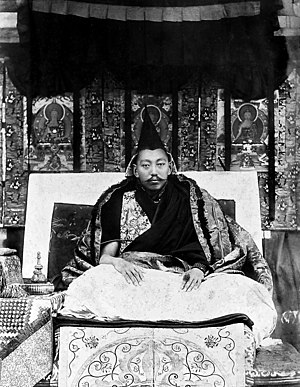13th Dalai Lama
| Dalai Lama incarnations |
|---|
| Fourteen incarnation of the Dalai Lama |
Ngawang Lobsang Thupten Gyatso Jigdral Chokley Namgyal, abbreviated to Thubten Gyatso[1] (Tibetan: ཐུབ་བསྟན་རྒྱ་མཚོ་, Wylie: Thub Bstan Rgya Mtsho; 12 February 1876 – 17 December 1933) was the 13th Dalai Lama of Tibet,[2] enthroned during a turbulent era and the collapse of the Qing Empire. Referred to as "the Great Thirteenth", he is also known for re-declaring Tibet's national independence, and for his reform and modernization initiatives.
In 1878, he was recognized as the reincarnation of the Dalai Lama. He was escorted to Lhasa and given his pre-novice vows by the Panchen Lama, Tenpai Wangchuk, and named "Ngawang Lobsang Thupten Gyatso Jigdral Chokley Namgyal".[1] In 1879, he was enthroned at the Potala Palace, but did not assume political power until 1895,[3] after he had reached his maturity.
Thubten Gyatso was an intellectual reformer and skillful politician. He was responsible for countering the British expedition to Tibet, restoring discipline in monastic life, and increasing the number of lay officials to avoid excessive power being placed in the hands of the monks.
- Further reading
- 13th Dalai Lama (Wikipedia)
 The Thirteenth Dalai Lama, Tubten Gyatso, Treasury of Lives
The Thirteenth Dalai Lama, Tubten Gyatso, Treasury of Lives
Notes
- ↑ 1.0 1.1 "Short Biographies of the Previous Dalai Lamas". DalaiLama.com. Retrieved 13 May 2018.
- ↑ Sheel, R. N. Rahul. "The Institution of the Dalai Lama". The Tibet Journal, Dharamsala, India. Vol. XIV No. 3. Autumn 1989, p. 28. ISSN 0970-5368
- ↑ "His Holiness the Thirteenth Dalai Lama, Thupten Gyatso". Namgyal Monastery. Archived from the original on 21 October 2009. Retrieved 10 October 2009.
| This article includes content from 13th Dalai Lama on Wikipedia (view authors). License under CC BY-SA 3.0. |
